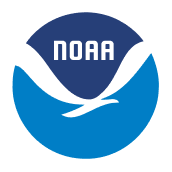Weather prediction workshop and community model upgrades spotlight GSL-driven advancements
GSL’s model developers and evaluators have been hard at work testing, advancing, and planning the next generation of numerical weather prediction models. Recently, this has included taking a leading role at a recent workshop for the scientific community and making significant contributions to recent releases of two major atmospheric modeling systems: the Weather Research and Forecasting (WRF) model and the Model for Prediction Across Scales (MPAS).

Innovative hexagonal grid utilized by MPAS, with higher resolution over the U.S. Image Credit: NCAR.
The National Science Foundation (NSF) National Center for Atmospheric Research (NCAR) hosted the Joint MPAS/WRF Users’ Workshop in Boulder, Colorado, in early June 2025, to discuss strategies for continued model improvement through collaborative development and evaluation. Attendees discussed updates on model developments, progress toward enhanced assimilation of new observations into the models, model physics advancements, applications to operational forecasting, and exploration of applying artificial intelligence to improve model predictions. GSL scientists were prominently involved, highlighting their accomplishments by giving seven presentations, two poster presentations, and chairing three sessions.
MPAS in particular has emerged as a critical piece of GSL’s model development work and shows promise as a candidate for incorporation into future NOAA modeling systems. It is also currently being implemented in the Unified Forecast System (UFS): a community-based Earth modeling system that leverages the expertise of scientists from across the field, not only those at NOAA. This community approach incorporates a number of different perspectives into model development, encouraging greater collaboration across organizations. The UFS is also being designed to simplify and streamline NOAA’s modeling suite.
GSL is evaluating experimental MPAS configurations to inform future configurations of the Rapid Refresh Forecast System (RRFS). These experimental forecast systems use a number of physics modeling approaches developed at GSL, can be paired with the Joint Effort for Data assimilation Integration (JEDI; partially developed at GSL), and are being evaluated in numerous applications by GSL developers for modeling severe storms, fire weather, harmful aerosols, hurricanes, and much more.

A major component of weather models such as MPAS is physics parameterization schemes, or techniques for estimating very complex, difficult-to-model characteristics of the atmosphere such as turbulence, thermodynamics, and radiation. One such scheme developed by GSL with other NOAA partners, the Unified Gravity Wave Physics package, helps MPAS more accurately represent the effects of terrain and gravity waves (low-amplitude variations in atmospheric pressure and motion) on atmospheric motions. Through a collaboration with NSF NCAR’s Mesoscale and Microscale Meteorology Laboratory, the Unified Gravity Wave Physics package was implemented in the community MPAS release (Version 8.3) in June 2025. GSL developers are currently working with NSF NCAR to implement other physics parameterization schemes into upcoming community MPAS releases.
Another major parameterization upgrade led by GSL is included in the April 2025 release of WRF (Version 4.7). WRF has been a prominent model for weather research and forecasting applications for decades and has benefitted from regular improvements throughout. The latest release from NCAR includes substantial improvements to the Mellor-Yamada-Nakanishi-Niino (MYNN) Planetary Boundary Layer (PBL) parameterization scheme, which is a widely used method for estimating turbulence in the PBL, or the lowest part of the atmosphere that is directly influenced by Earth’s surface. GSL’s improvements to the MYNN scheme will allow WRF users to take advantage of the updated parameterization that is tuned for better performance in WRF rather than other models, and which results in improved computational speed by 10-15%.

In addition to model development, GSL is a leader in model testing, evaluation, and verification, which quantify a model’s accuracy, skill, and usefulness. GSL researchers are part of the Developmental Testbed Center (DTC), a NCAR-NOAA collaborative organization that tests and evaluates models, technologies, and systems to accelerate the transition of research to operations.
Many of GSL’s physics upgrades are made publicly available as part of the UFS Common Community Physics Package (CCPP). In June 2025, DTC released version 7.0.1 of CCPP’s Single-Column Model (SCM), a simplified host model used to test physics parameterizations, with enhanced testing capabilities and updated documentation. As part of the CCPP development team, GSL’s contributions to this system are used to help NOAA and the community improve operational and experimental forecasts in some of the most widely-used forecast models, such as the Global Forecast System (GFS) and RRFS, while also creating a key integration with NOAA’s high-performance computing platforms.
One of the tools used to evaluate these models is the enhanced Model Evaluation Tools (METplus), which itself was upgraded in May 2025. A collaboration between NSF NCAR, NOAA, and the U.S. Air Force, METplus is a verification framework for a wide range of weather models, developed with community input. METplus version 6.1 includes significant contributions by the GSL DTC team, including software updates, improved workflows, and new use cases.
These recent model and system releases, in addition to the significant presence at the MPAS/WRF Users’ Workshop, demonstrate the continued investment of GSL and its affiliates from the Cooperative Institute for Research in the Atmosphere (CIRA/Colorado State University) and Cooperative Institute for Research in Environmental Studies (CIRES/University of Colorado) in advancing numerical weather prediction in the United States, ensuring that NOAA and GSL remain at the forefront of moving global and regional weather prediction forward.
Our Mission
Lead research and directed development through the transition of environmental data, models, products, tools, and services to support commerce, protect life and property, and promote a scientifically literate public.
Research Areas
Organizational Excellence, Earth System Prediction, Advanced Technologies, and Decision Support are the foundation to achieving the GSL Grand Challenge: Deliver actionable global storm-scale prediction and environmental information through advanced technologies to serve society.
Global Systems Laboratory

